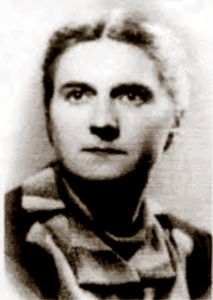Grażyna Lipińska was born on April 12, 1902 in Warsaw. She served as a nurse and a liaison officer during the defense of Lviv (1918–1919), then she participated in the Battle of Warsaw (1920), the Third Silesian Uprising (1921) and also in the defense of Grodno (1939). She belonged to the Union of Armed Struggle, which then was transformed into the Home Army, organizing intelligence structures in Belarusian Minsk.
She fulfilled her professional aspirations as a chemist and a teacher. In 1928, as one of the first women, she graduated from the Department of Chemical Engineering at the Chemical Faculty of the Warsaw University of Technology. She was appointed to work in a commission dealing with changes in the education system at The Ministry of Religious Affairs and Public Education. In parallel, she was preparing a doctoral dissertation.
Her career was interrupted by the outbreak of World War II. Appointed by the Commander-in-Chief of the Female Military Training as a commandant of the Social Emergency, she went to Grodno and after September 17 she participated in its defence. After the city was captured by the Red Army, she was arrested and (in 1941) sentenced to 10 years in labour camps and 15 years of exile. After the outbreak of the German-Soviet war, together with her arrested comrades, she went through the Minsk-Chervyen execution route called ‘the way of death’, on which NKVD officers murdered escorted prisoners. She managed to escape and return to Warsaw.
In Warsaw, under the pseudonym ‘Danuta’ she undertook underground activity. In 1942 she was delegated to work for military intelligence of the Home Army in Belarus, Minsk, where in 1944 she was arrested by the NKVD and convicted (for 6 years in GUL-ag camp) of alleged espionage to the advantage of England. Another accusation (in 1950) was the activity in the Home Army, for which Lipińska was sentenced again, but this time to 25 years of labour camps. Due to political changes, however, the sentence was reduced to 12 years. She was imprisoned in the Lubyanka Building in Moscow, in Vilnius and Novosibirsk, and then in labour camps, including: Orsha, Gorky, Bratsk, Sucho-Bezwodnoje. She worked felling and grubbing up trees, building a railway line, a hydroelectric power plant and a bridge, extinguishing fires, digging potatoes and cleaning sanitary facilities.
In 1956 she was pardoned and released from the labour camp. In the same year she returned to Warsaw, where she began working in the Main Library of the Warsaw University of Technology. After retiring, she started editing the Dictionary of women-participants in the struggle for Polish independence in 1939–1945, and in 1980 she joined the ’Solidarity’ movement. Her memories from the years of katorga were published in Paris in 1988, entitled If I Forget About Them… Grażyna Lipińska has been honored with many decorations, including The Virtuti Militari Order and The Order of the Rebirth of Poland. Just before her death, she was also promoted to the rank of lieutenant colonel. She died on November 30, 1995 in Warsaw.
Translated from Polish: Sylwia Szarejko, Kamila Czechowska
Biogram based on the book: S. Szarejko, Kobiety niepokonane/Undefeated Woman, Białystok 2019, edited by Sybir Memorial Museum




